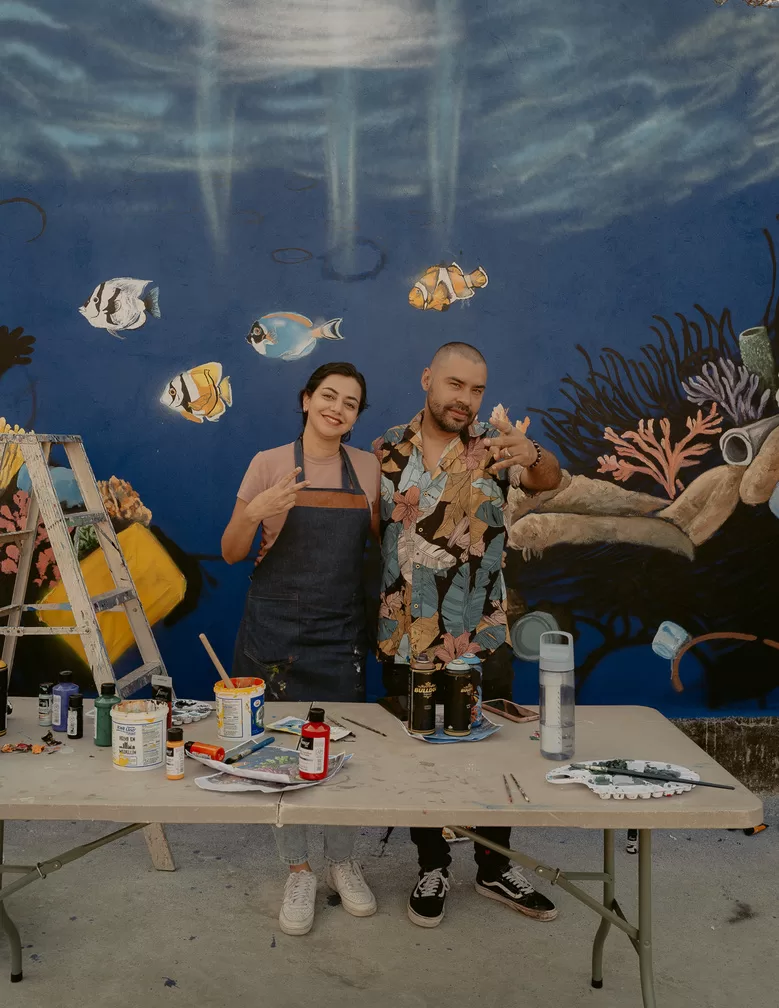Happy Eco News The Soft Power of Art for Environmental Activism
Reading Time: 4 minutes
The soft power of art for environmental activism
I’ve always believed in the quiet power of art—how it can enter through the heart before asking the mind to act. But painting a mural in Comuna 13, Medellín, showed me just how far those ripples can reach.
Comuna 13 was once considered one of the most dangerous neighborhoods in the world. Years of violence and displacement had taken their toll on the community. But over time, something extraordinary happened: art became a tool for healing, storytelling, and reclaiming space. Local artists began covering walls with murals that told their truth—not just of pain, but of resilience, culture, and pride. The neighborhood transformed into a living gallery, where color replaced fear and creativity reshaped identity.
I came to Comuna 13 as an artist and environmental advocate, with no grand plan—just a deep desire to collaborate and connect. As a digital nomad, I travel the world creating art that sparks conversations about the environment and social justice. But this experience was different. Being in a place where art literally changed the course of a community’s story stirred something in me. It made me want to use that same energy to talk about a cause that breaks my heart every day: the state of our planet.
And then I met Usuga—a local muralist, hip-hop artist, and visionary aiming to bridge local and global environmental concerns within his community.
Once he heard my vision and saw my work, he offered me something unexpected: a wall.
That offer turned into a conversation and then a collaboration as we dreamt up all the exciting possibilities that could come from it.
We decided to paint a mural about plastic pollution in our oceans—an underwater scene we’re all used to seeing on screen, but with the unexpected twist of pollution woven into it, which unfortunately reflects the true reality of our oceans.

This wasn’t just about the ocean. It was about the things we throw away. The everyday purchasing choices we make. The things we don’t think about because we’ve stopped seeing them. And the quiet violence of that.
We didn’t have funding, and I was eager to support this under-resourced community. So we launched a small fundraiser, and I shared the vision on my Instagram page. The response surprised me. Friends, followers, and strangers chipped in, and in just 24 hours, we had enough to cover materials, ladders, and paint. Reaching that goal felt like confirmation that people care. It felt like the first ripple.
Weeks passed as we painted. We filled the wall with a vibrant coral reef—fish swimming freely, with one caught in plastic. Scattered throughout the scene were visual references to the everyday items we discard: water bottles, plastic bags, takeout containers. It was a haunting image, meant to spark empathy, not despair.
As we painted, kids stopped to watch, tourists took pictures, and locals asked questions. I invited anyone interested to paint their own piece of coral—or garbage—on the wall. Everyone felt like the mural was theirs.
A little boy stared for hours before finally asking, “Why is there so much garbage?” I told him what’s happening in our oceans. He thought for a moment and said, “We can fix it, right?”
That. Right there. That’s why I make art.
It wasn’t just a mural anymore. It became a starting point—a way in. For conversations. For reflection. For action.
That’s what art does when we let it meet people where they are. It bypasses overwhelm and invites us to feel before we think. When people feel something, they’re more open to caring, learning, and acting.
Once we finished, Usuga created a music video around the mural, using one of his songs from his new album—a powerful piece about consumerism and environmental destruction. The mural became the visual anchor for a message that moved with rhythm, lyrics, and local voice. It wasn’t just painted—it was heard.
Then, a talented friend created an augmented reality (AR) overlay. Now, when people scan the mural with their phones, it comes alive. The seaweed moves, the plastic sways, and the ocean flows. People gasp, and some get quiet. It’s one thing to see a problem; it’s another to feel it.
Tour guides started showing up. “What’s the story?” they’d ask. “What should we share with our travelers?” Just like that, each guide became a storyteller, an ambassador. The ripple grew.
And it kept growing.

My own friend circle started thinking more about their plastic use. They brought their own water bottles, said no to plastic bags, and made small changes that felt like big ones. We hosted a clean-up. Conversations changed. People changed.
When it came time to launch the mural, I didn’t have to plan it alone. The community offered help—designing brochures, organizing music, serving drinks in reusable cups, and helping spread the word. And then Usuga offered something beautiful: a corner of his brand-new creative storefront—the very wall we’d painted on.
Inside, we painted a giant whale on the ceiling, surrounded by swirling plastic. The entire space now carries the energy of the project. We’re working on a line of collaborative art and environmental merch, with proceeds going toward supporting the local art scene in Comuna 13.
None of this was planned. It was felt. It was shared. It was built together.
And to me, that’s the magic of art.
Art doesn’t shout. It doesn’t force. It invites. It helps people feel before they understand. It creates a soft entry point into hard conversations—and in that softness, things begin to shift.
Comuna 13 reminded me why I do what I do. Why I’ll keep showing up, brush in hand, heart open, wherever there’s a story worth telling.
Because that one turtle we painted? It’s still swimming. In music. In augmented reality. In conversations. In choices. In community.
And the ripples haven’t stopped.
The post The Soft Power of Art for Environmental Activism appeared first on Happy Eco News.
